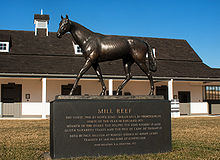The wife of Mill Reef's UK trainer, made wonderful scrapbooks, filled with photographs and newspaper clippings that we have been commissioned to digitise to high quality Archival TIFF files, with our archival processing applied.
If we can support you with your archival digitisation projects, please do not hestiate to contact us: cheryl@oxfordduplicationcentre.com
https://en.wikipedia.org/wiki/Mill_Reef
Mill Reef (1968–1986) was a Champion Thoroughbred racehorse and sire. He was bred in the United States but was trained in the United Kingdom throughout his racing career which lasted from 1970 to 1972. Mill Reef won twelve of his fourteen races and finished second in the other two. He was an outstanding two-year-old in 1970, and proved even better at three, winning the Epsom Derby, the Eclipse Stakes, the King George VI and Queen Elizabeth Stakes and the Prix de l'Arc de Triomphe. He won both his starts as a four-year-old before his racing career was ended by injury.
He was an exact contemporary of another British-trained champion, the English-bred Brigadier Gerard who defeated him in their only racecourse meeting in the 2000 Guineas. As the race was over Brigadier Gerard's optimum distance of one mile, the relative merits of the two colts continued to be the subject of debate.
| Mill Reef | |
|---|---|
 This statue of Mill Reef stands in the center of Rokeby Stables in Upperville, Virginia | |
| Sire | Never Bend |
| Grandsire | Nasrullah |
| Dam | Milan Mill |
| Damsire | Princequillo |
| Sex | Stallion |
| Foaled | 1968 |
| Country | United States |
| Colour | Bay |
| Breeder | Paul Mellon |
| Owner | Paul Mellon Colours: Black, gold cross and stripe on cap. |
| Trainer | Ian Balding |
| Record | 14:12-2-0 |
| Earnings | £309,225 |
| Major wins | |
| Coventry Stakes (1970) Gimcrack Stakes (1970) Dewhurst Stakes (1970) Greenham Stakes (1971) Epsom Derby (1971) Eclipse Stakes (1971) K. George VI & Q. Elizabeth Stakes (1971) Prix de l'Arc de Triomphe (1971) Prix Ganay (1972) Coronation Cup (1972) | |
| Awards | |
| English 3-Yr-Old Champion Colt (1971) European Horse of the Year (1971) English Champion Older Horse (1972) Timeform rating: 141 Leading sire in GB & Ireland (1978, 1987) | |
| Honours | |
| #4 - 20th Century's Top 100 European Racehorses Life-size statue at The National Stud, Newmarket Mill Reef Stakes at Newbury Racecourse | |
| Last updated on 9 June 2009 | |

Comments
Post a Comment